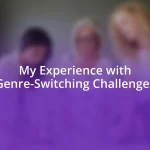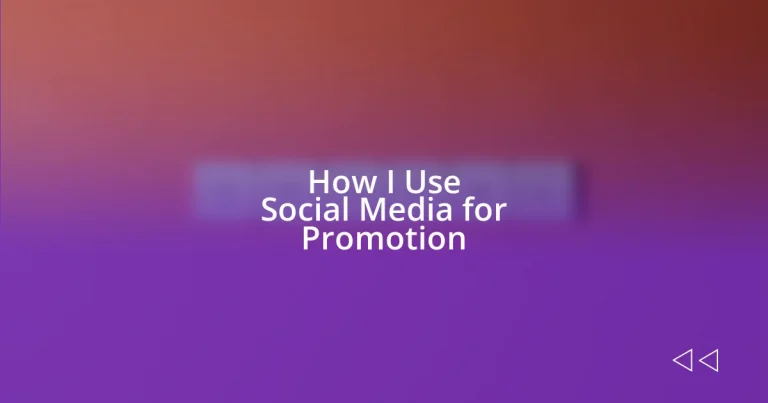Key takeaways:
- Understanding and engaging with your audience through tailored content and storytelling can significantly enhance social media promotion.
- Selecting the right social media platforms based on audience preferences leads to more impactful and effective promotional strategies.
- Collaborating with influencers and adapting to emerging trends are crucial for expanding reach and maintaining relevance in the digital space.
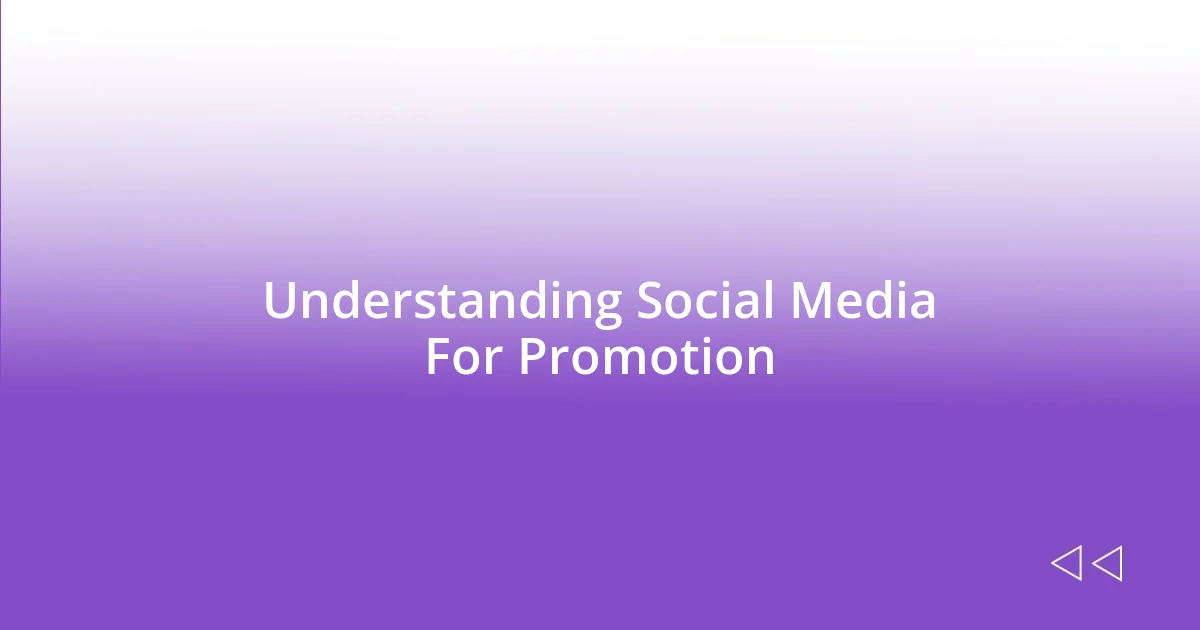
Understanding Social Media For Promotion
When I first jumped into using social media for promotion, I was overwhelmed. How could I possibly stand out amidst the noise? This initial struggle pushed me to focus on target audiences and tailor my content specifically for them, which turned out to be a game-changer in my approach.
I vividly remember a campaign I launched on Instagram where I shared behind-the-scenes moments of my work. The connection I formed with my audience was profound; they weren’t just passive viewers, but companions on my journey. This taught me that understanding your audience’s interests and emotions can drive genuine engagement, transforming simple posts into impactful conversations.
One of the most surprising realizations for me was the power of storytelling, especially through platforms like Facebook and TikTok. Rather than merely promoting my products, I began sharing stories related to them. Have you ever noticed how a compelling narrative can captivate attention? It certainly worked for me. Embracing a narrative approach allowed me to build a community, fostering loyalty and warmth that pure promotion never could.
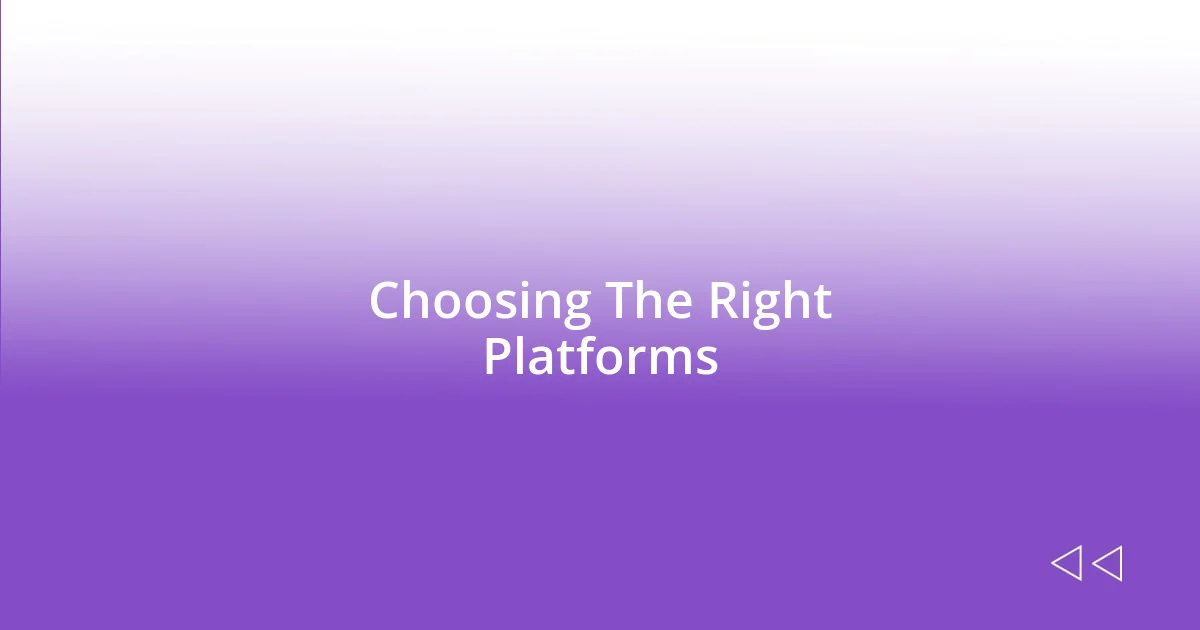
Choosing The Right Platforms
Choosing the right social media platforms is crucial for effective promotion. I’ve learned through trial and error that not every platform suits every brand. For instance, while I found great success on Instagram due to its visual appeal, I struggled to engage on Twitter where brevity reigns. It’s vital to consider where your target audience spends their time and what types of content resonate with them.
Here’s a quick guide to help you decide which platform is best for your needs:
– Instagram: Ideal for visually-driven brands aiming to showcase products through high-quality images and stories.
– Facebook: Great for building community and sharing in-depth narratives or longer content.
– LinkedIn: Perfect for B2B promotion, connecting with industry professionals, and sharing expert insights.
– TikTok: Excellent for those targeting a younger audience with creative, entertaining video content.
– Twitter: Best for real-time updates, customer interaction, and engaging in trending conversations.
When I started focusing my efforts on the right platforms, it felt like finding a key to unlock a door. Seeing engagement blossom on Instagram, where I shared vibrant visuals of my products, was incredibly fulfilling. It reinforced my belief that understanding where my audience “hangs out” and how they prefer to consume content can make all the difference in impact.
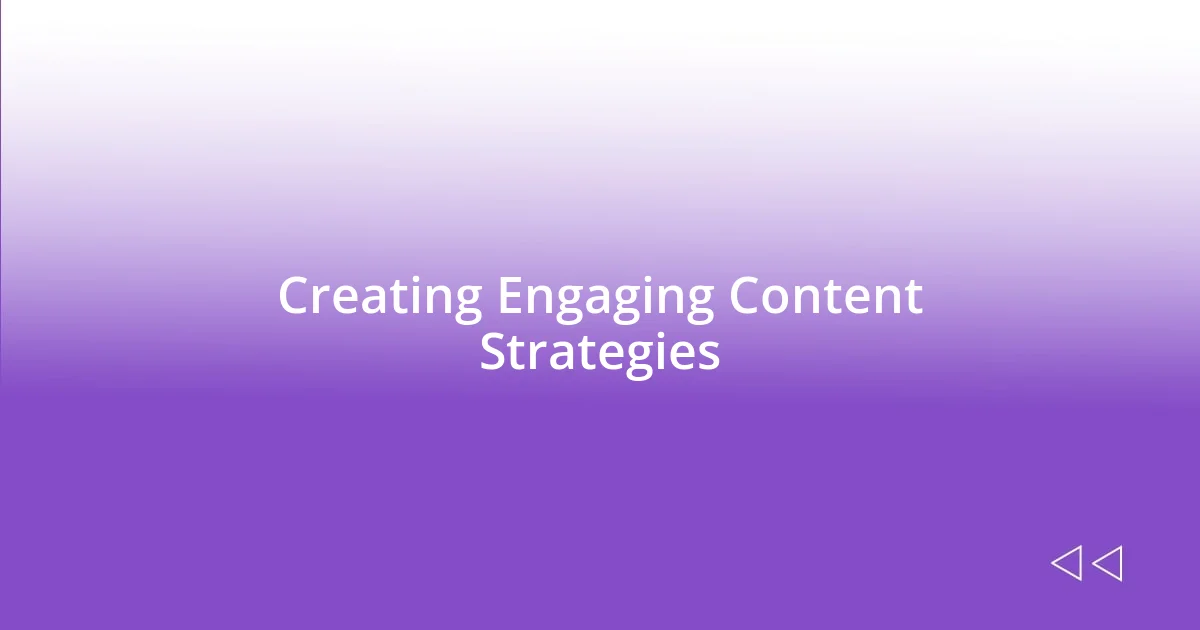
Creating Engaging Content Strategies
Creating content that resonates is a fine art. I remember diving into a series of polls on Instagram Stories to get direct feedback from my audience. The thrill of seeing their responses helped me craft content that felt personal and relevant. By actively engaging with them, it transformed my content from a one-way street into a dynamic conversation that not only enriched my posts but made my audience feel valued.
Experimentation is key when formulating content strategies. For instance, I tried a mix of tutorials and user-generated content on my Facebook page. To my surprise, people loved sharing their own experiences with my products. This collaborative approach not only increased engagement but created a sense of community. I learned to embrace the unpredictability of social media, allowing my audience to become co-creators in my brand journey.
In incorporating visuals, I’ve found that eye-catching graphics or short videos can really elevate engagement levels. I once shared a time-lapse video of my process, and the comments poured in! People were fascinated by the journey, and that curiosity translated into better interaction rates. This experience highlighted that when you give a glimpse behind the curtain, your audience is more likely to form a deeper connection with what you create.
| Content Type | Engagement Strategy |
|---|---|
| Polls/Questions | Encourage feedback and involvement to tailor future content |
| User-Generated Content | Foster community by sharing audience experiences |
| Visual Storytelling | Utilize captivating imagery or videos to draw in viewers |
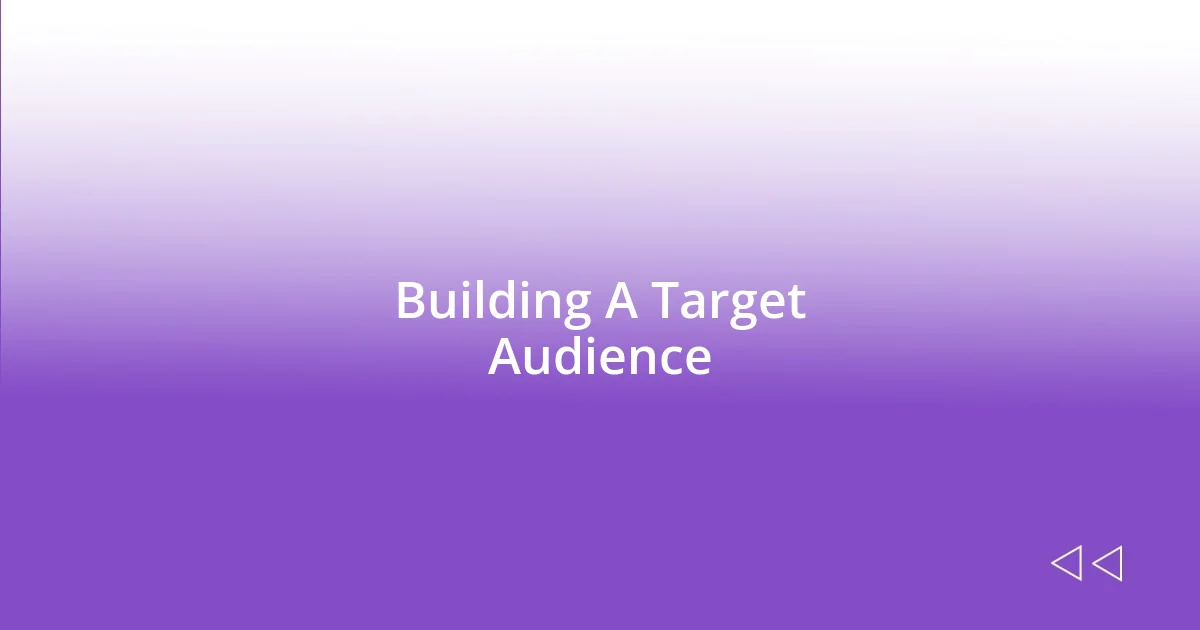
Building A Target Audience
Building a target audience requires true understanding and a bit of empathy. I recall a time when I analyzed my insights and discovered that my followers were primarily young adults. This revelation prompted me to tailor my tone and messaging to reflect their lifestyles and preferences. Isn’t it fascinating how knowing who your audience is can dramatically shift your approach?
Finding my niche was empowering. After engaging with my audience through comments and direct messages, I felt more connected than ever. Their feedback became invaluable; it was like having a personal focus group at my fingertips. How often do we overlook the voices of those who support us? By opening myself up to their opinions, I was able to create content that truly resonated, and in return, they felt heard and appreciated.
I always emphasize the importance of authenticity when building a target audience. One time, I shared a behind-the-scenes look at a particularly challenging project I was working on. The response was overwhelming—people shared their own struggles and successes, and I realized just how relatable vulnerability can be. It’s moments like these that deepen connection and loyalty. Don’t you think that when we show our true selves, our audience feels invited to do the same?
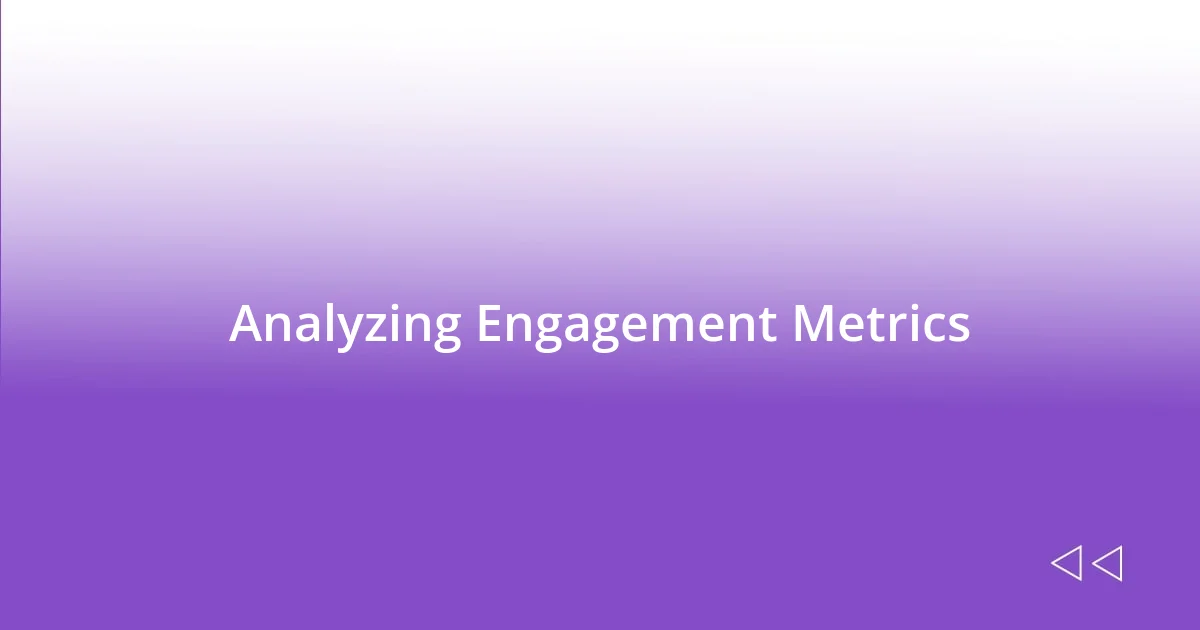
Analyzing Engagement Metrics
Analyzing engagement metrics is like peering through a magnifying glass at the health of your social media presence. I recall a time when I noticed that my posts featuring inspirational quotes received significantly more likes than my product promotions. This was a lightbulb moment for me. It made me rethink my content strategy and focus on what truly resonates with my audience. Have you ever had an experience where the data revealed something surprising?
Diving into metrics isn’t just about numbers; it’s a narrative waiting to be uncovered. For instance, I often monitor comments and shares alongside likes. I once discovered a particular post with minimal likes but a flood of heartfelt comments. This taught me that deeper interactions sometimes matter more than surface-level engagement. It got me thinking—what does engagement really mean in your context?
Comparing my content’s performance week over week has become a routine part of my process. I remember a week when a themed series I ran brought a spike in engagement, prompting me to plan similar content. Reflecting on this, it made me appreciate the importance of adaptability. I’ve learned that analyzing engagement metrics is not a one-time effort but an ongoing journey in understanding and growing together with my audience. How often do you reflect on your own engagement data?
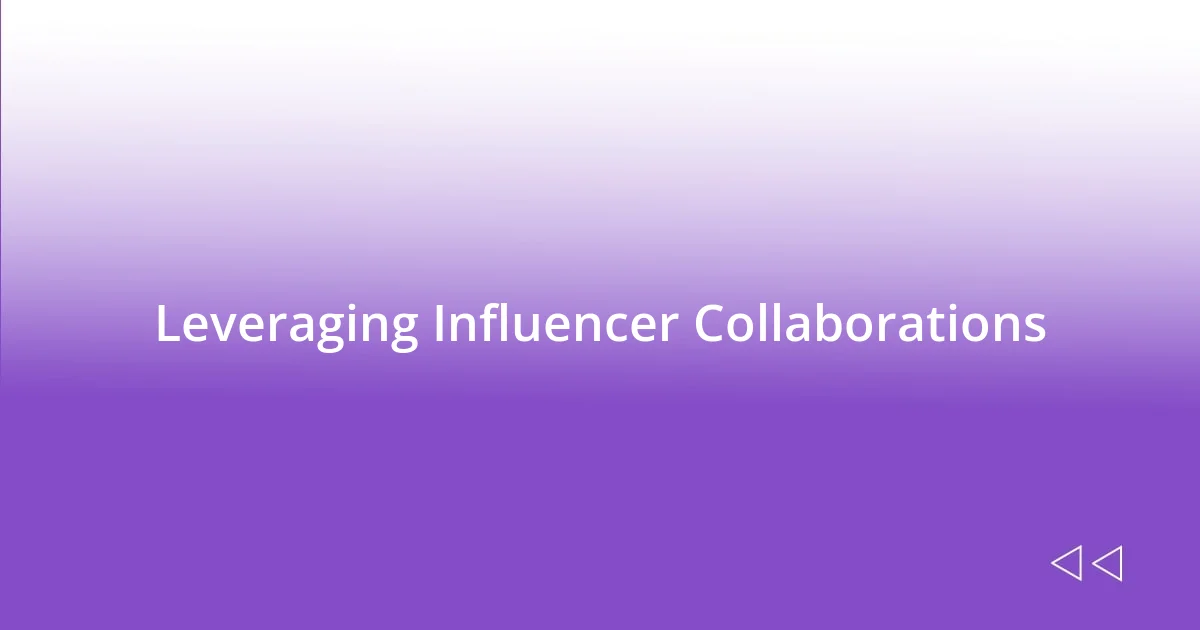
Leveraging Influencer Collaborations
Collaborating with influencers has been a game-changer in my promotional efforts. I remember when I teamed up with a local influencer who echoed my values. Their authentic endorsement of my product expanded my reach and added a sense of credibility that I simply couldn’t replicate on my own. Have you ever wondered how much a single collaboration could change the perception of your brand?
What I’ve found particularly fascinating is how these partnerships foster mutual growth. During one memorable campaign, both my brand and the influencer organized a giveaway that resulted in a significant increase in followers for both parties. The excitement generated not only brought our audiences together but also created an engaging community vibe. Isn’t it amazing how collaboration can amplify our voices and create a wave of enthusiasm?
Additionally, selecting the right influencers is crucial. A few months ago, I worked with someone whose audience aligned well with my target demographic. Their feedback was invaluable, and it provided me with fresh insights into the market. Seeing my product in their content, framed by their unique storytelling, made me realize just how powerful influencer marketing can be when artists and brands work hand in hand. How do you strategically choose the influencers you collaborate with?
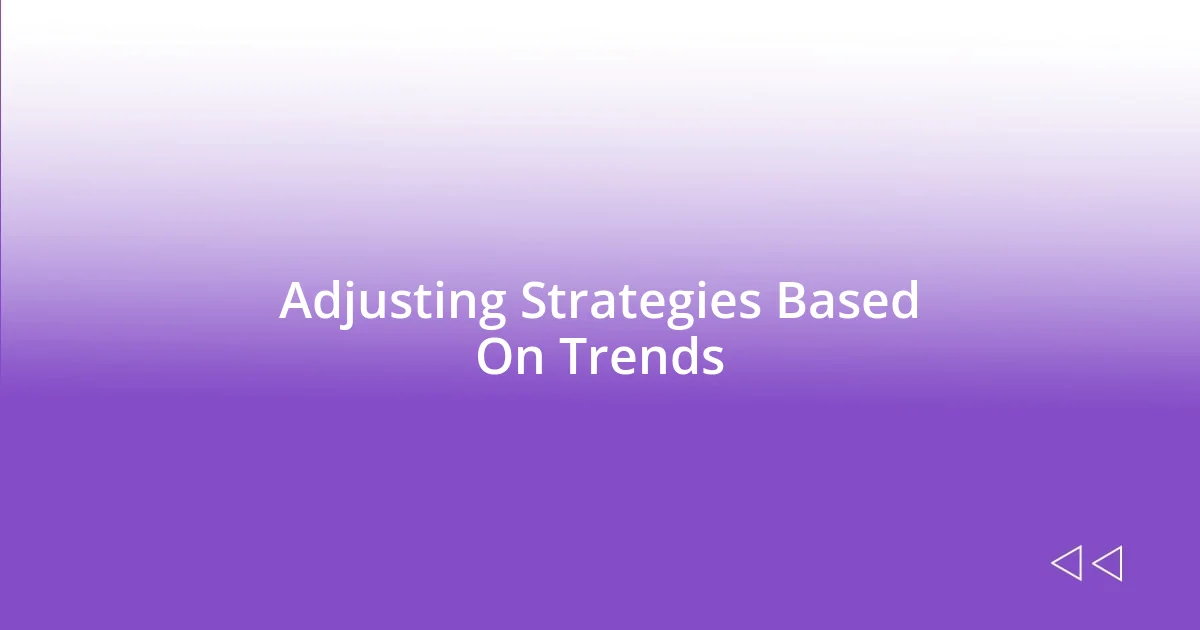
Adjusting Strategies Based On Trends
Adjusting my social media strategies based on emerging trends has been essential for staying relevant. I vividly remember a period when reels and short videos began to dominate platforms, and I felt a bit hesitant to jump on that bandwagon. But, after seeing a few well-crafted, engaging clips that resonated with my audience, I decided to take the plunge and experiment with video content. The response was overwhelmingly positive, causing me to rethink how I present my brand in the digital space. Have you ever had a similar experience where you hesitated to adopt a trend, only to find that it could really boost your engagement?
I’ve also learned to keep my ear to the ground for viral trends that align with my niche. Whether it’s a catchy challenge, a popular meme format, or a new hashtag, tapping into these trends can bring a fresh energy to my promotional efforts. For instance, I once participated in a trending hashtag related to sustainability that perfectly matched my brand’s mission. Not only did it greatly increase visibility, but it also fostered conversations that deeply connected my audience with my values. How often do you browse through trending hashtags to see if they could work for your promotions?
Finally, I find that flexibility is key when approaching trend-based strategies. I recall a time when a trending topic shifted overnight, and brands that adapted quickly reaped the benefits. I didn’t want to get left behind, so I devoted a day to crafting relevant content that reflected the buzz, integrating trending discussions into my messaging. The result was a surge in engagement, and that taught me a valuable lesson about responsiveness in social media marketing. Are you willing to adjust your tactics on the fly when trends change?











